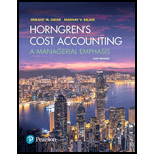
Concept explainers
Support-department cost allocations; single-department cost pools; direct, step-down, and reciprocal methods. The Martinez Company has two products. Product 1 is manufactured entirely in department X. Product 2 is manufactured entirely in department Y. To produce these two products, the Martinez Company has two support departments: A (a materials-handling department) and B (a power-generating department).
An analysis of the work done by departments A and B in a typical period follows:
| Used by | ||||
| Supplied by | A | B | X | Y |
| A | — | 400 | 1,000 | 600 |
| B | 1,500 | — | 250 | 750 |
The work done in department A is measured by the direct labor-hours of materials-handling time. The work done in department B is measured by the kilowatt-hours of power. The budgeted costs of the support departments for the coming year are as follows:
| Department A (Materials Handling) | Department B (Power Generation) | |
| Variable indirect labor and indirect materials costs | $300,000 | $ 30,000 |
| Supervision | 90,000 | 50,000 |
| 30,000 | 100,000 | |
| $420,000 | $180,000 | |
| + Power costs | + Materials-handling costs |
The budgeted costs of the operating departments for the coming year are $2,500,000 for department X and $1,900,000 for department Y.
Supervision costs are salary costs. Depreciation in department B is the straight-line depreciation of power-generation equipment in its 19th year of an estimated 25-year useful life; it is old, but well-maintained, equipment.
- 1. What are the allocations of costs of support departments A and B to operating departments X and Y using (a) the direct method, (b) the step-down method (allocate department A first), (c) the step-down method (allocate department B first), and (d) the reciprocal method?
- 2. An outside company has offered to supply all the power needed by the Martinez Company and to provide all the services of the present power department. The cost of this service will be $80 per kilowatt-hour of power. Should Martinez accept? Explain.
Want to see the full answer?
Check out a sample textbook solution
Chapter 15 Solutions
REVEL for Horngren's Cost Accounting: A Managerial Emphasis -- Access Card (16th Edition) (What's New in Accounting)
- Mercury Inc. had 30,000 units of ending inventory recorded at $9.50 per unit using FIFO method. Current replacement cost is $5.25 per unit. Which amount should be reported as Ending Merchandise Inventory on the balance sheet using lower-of-cost-or-market rule?arrow_forwardWhat is the cost of goods sold?arrow_forwardwhat is the operating leverage? account questionsarrow_forward
- Provide Right Answerarrow_forwardParker Industries applies manufacturing overhead costs to products at a budgeted indirect-cost rate of $60 per direct manufacturing labor hour. A client has requested a bid on a special order for a customized bracelet. Estimates for this order include: Direct materials of $52,000, 450 direct manufacturing labor hours at $18 per hour, and a 40% markup rate on total manufacturing costs. What is the bid price for this special order?arrow_forwardNet Accounts receivable beginning of year: 28400arrow_forward
 Principles of Cost AccountingAccountingISBN:9781305087408Author:Edward J. Vanderbeck, Maria R. MitchellPublisher:Cengage Learning
Principles of Cost AccountingAccountingISBN:9781305087408Author:Edward J. Vanderbeck, Maria R. MitchellPublisher:Cengage Learning Managerial AccountingAccountingISBN:9781337912020Author:Carl Warren, Ph.d. Cma William B. TaylerPublisher:South-Western College Pub
Managerial AccountingAccountingISBN:9781337912020Author:Carl Warren, Ph.d. Cma William B. TaylerPublisher:South-Western College Pub Cornerstones of Cost Management (Cornerstones Ser...AccountingISBN:9781305970663Author:Don R. Hansen, Maryanne M. MowenPublisher:Cengage Learning
Cornerstones of Cost Management (Cornerstones Ser...AccountingISBN:9781305970663Author:Don R. Hansen, Maryanne M. MowenPublisher:Cengage Learning Financial And Managerial AccountingAccountingISBN:9781337902663Author:WARREN, Carl S.Publisher:Cengage Learning,
Financial And Managerial AccountingAccountingISBN:9781337902663Author:WARREN, Carl S.Publisher:Cengage Learning,



